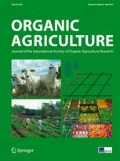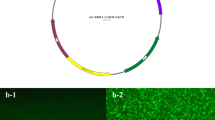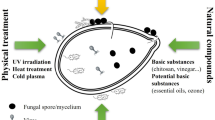Abstract
A promising direction in organic agriculture is the stimulation of growth and development of cultivated plants, induction of resistance to pathogens using biologically active substances of plant origin. From this point of view, the special interest presents the allelopathic active plant of the family Polygonaceae reynoutria Japanese (Reynoutria japonica Houtt.), which is an aggressive invasive species, widely spread in the countries of the Western Europe, in the USA, and the European part of Russia. Dealcoholized aqueous solutions with the concentrations of 0.5%, 1%, 5%, 10%, 15%, and 20% which were obtained from 70% EtOH extract of green mass of R. japonica were used for the spraying of seeds of the test cultures; Triticum aestivum L., Hordeum vulgare L., and Glycine max (L.) Merr. were germinated at a temperature of 20 ± 1 °C in the planters. The studied concentrations of the extract had antifungal activity and stimulated the germination energy and the seed sprouting in comparison with the untreated control. The maximum positive effect upon the growth processes of seeds of the test cultures had the extract solutions in concentrations of 1% and 5%—the sprouting increased to 93.5–99.5%, which is higher than the control version by 7–21%. An increase in the concentration of the solution above 5% did not lead to a further increase in the efficiency of the extract. It is interesting that under the treatment of crops with the same concentrations of solutions of the extract of R. japonica, the response reaction of the allelochemicals of T. aestivum is higher than that of H. vulgare and G. max. In the laboratory experiment to study the effect of the extract of R. japonica for the viability of the fungus Septoria glycines Hemmi, it was found that 1% solution of the extract suppressed the growth of S. glycines: only 75% of the total number of spores placed into the thermostat sprouted while 90% of the spores were viable at the control.

Similar content being viewed by others
References
Arin L, Balci H (2016) The effect of some organic acid and plant-derived material treatments on the germination and emergence of lettuce. Org Agric 6(3):199–201 https://link.springer.com/content/pdf/10.1007%2Fs13165-015-0128-0.pdf. Accessed 30 Nov 2018
Borovaya S, Zorikova O, Manyakhin A (2018) Method of pre-sowing seed treatment. Patent 2675534 (RU). Int. Cl. А01С1/00 (2006.01), А01N65/00 (2009.01)
Cárdenas CD, Tumbaco M, Pozo-Rivera WE, Morejón M, Rojas M, Gooty JM, Cuaycal A (2018) Antifungal activity and bio-stimulating effect generated by two botanical extracts in Alpinia purpurata and Heliconia wagneriana cultivation. Org Agric 8(4):325–333
Daayf F, Schmitt A, Belanger RR (1995) The effects of plant extracts of Reynoutria sachalinensis on powdery mildew development and leaf physiology of long English cucumber. Plant Dis 79(6):577–580
Dehliz A, Lakhdari W, Acheuk F, Aoudjit R, Benlamoudi W, Mlik R, Hammi H, Chergui S, Guermit K, Matallah S (2018) Euphorbia guyoniana aqueous extract efficiency against tomato leaf miner in southern East Algeria. Org Agric 8(4):349–354
Dubrovina A, Manyakhin A, Zhuravlev Y, Kiselev K (2010) Resveratrol content and expression of phenylalanine ammonia-lyase and stilbene synthase genes in rolе transgenic cell cultures of Vitis amurensis. Appl Microbiol Biotechnol 3:127–736 http://biosoil.ru/Files/00009353.pdf. Accessed 12 Nov 2018
Eloff JN, Angeh IE, McGaw LJ (2017) Solvent-solvent fractionation can increase the antifungal activity of a Melianthus comosus (Melianthaceae) acetone leaf extract to yield a potentially useful commercial antifungal product. Ind Crop Prod 110:103–112
Halafian A (2007) STATISTICS 6. Statistical analysis of data. 3-e Izd. Textbook. M. LLC Binom-Press, Moscow 512 pp
Hua Y, Zhou J, Niw Cheng C (2001) Studies on the constituents of Reynoutria ja-ponica Houtt. Nat Prod Res Dev 13(6):16–18
Kalinova J (2010) Allelopathy and organic farming. In: Lichtfouse E (ed) Sociology, organic farming, climate. Change and soil science. Sustainable agriculture reviews 3. Springer Science+Business Media, B.V, Dordrecht, pp 379–418
Karavayev V, Solntsev M, Parenago O, Glazunov S (2010) Stimulator of plant growth and development. RU No 2395967, Int. Cl. A 01 N 65/00, B 01 D 11/00 (2006.01)
Konstantinidou-Doltsinis S, Markellou E, Kasselaki A-M, Fanouraki MN, Koumaki CM, Schmitt A, Liopa-Tsakalidis A, Malathrakis NE (2006) Efficacy of Milsana®, a formulated plant extract from Reynoutria sachalinensis, against powdery mildew of tomato (Leveillula taurica). BioControl 51(3):375–392
Liu X, Wu L, Song G, Liu K, Zhang X, Zhang Y (2000) Study of chemical constituents of Polygonum cuspidatum Sieb. Chem Abstr 132(276624):17–20
Luo S, Jin X, Ye J, Znang P (1999) Advances in research on 3,4,5-trihydroxistilbene 3-β-D-glucoside, an effective constituent from Polygonum cuspidatum Sieb. et Zucc. Zhongguo Yaolixue Yu Dailixue Zazhi 13(1):1–4
Mazhawidza E, Mvumi BM (2017) Field evaluation of aqueous indigenous plant extracts against the diamondback moth, Plutella xylostella L. and the rape aphid, Brevicoryne brassicae L. in brassica production. Ind Crop Prod 110:36–44
Merwad A-RMA (2018) Using Moringa oleifera extract as biostimulant enhancing the growth, yield and nutrients accumulation of pea plants. J Plant Nutr 41(4):425–431
Mkindi A, Mpumi N, Tembo Y, Stevenson PC, Ndakidemi PA, Mtei K, Machunda R, Belmain SR (2017) Invasive weeds with pesticidal properties as potential new crops. Ind Crop Prod 110:113–122 https://www.sciencedirect.com/science/article/pii/S0926669017303886. Accessed 10 Jul 2018
Phiri C, Mbewe DN (2010) Influence of Moringa oleifera leaf extracts on germination and seedling survival of three common legumes. Int J Agric Biol 12(2):315–317
Sayed MA, Imam R, Siddiqui MN, Raihanun-Nabi SM, Aktar S, Das SR (2016) Allelopathic activity of Leonurus siribicus L. on seed germination and seedling growth of wheat and identification of 4-hydroxy benzoic acid as an allelochemical by chromatography. Pak J Bot 48(3):1189–1195
Shaw RH, Seiger LA (2002) Japanese knotweed biological control of invasive plants in the Eastern United States. USDA APHIS PPQ and USDA, The University of Georgia, pp 159–166
Suksungworn R, Sanevas N, Wongkantrakorn N, Fangern N, Vajrodaya S, Duangsrisai S (2016) Phytotoxic effect of Haldina cordifolia on germination, seedling growth and root cell viability of weeds and crop plants. NJAS - Wageningen J Life Sci 78:175–181
Talibi I, Amkraz N, Askarne L, Msanda F, Saadi B, Boudyach EH, Boubaker H, Bouizgarne B, Ait Ben Aoumar A (2011) Antibacterial activity of moroccan plants extracts against Clavibacter michiganensis subsp. michiganensis, the causal agent of tomatoes’ bacterial canker. J Med Plants Res 5(17):4332–4338
Tayel AA, Moussa SH, Salem MF, Mazrou KE, El-Tras WF (2016) Control of citrus molds using bioactive coatings incorporated with fungal chitosan/plant extracts composite. J Sci Food Agric 96(4):1306–1312
Vastano B, Chen Y, Zhu N, Ho C, Zhou Z, Rosen R (2000) Isolation and identification of stilbenes in two varieties of Polygonum cuspidatum. J Agric Food 48(2):253–156
Věchet L, Šerá B (2015) Effectiveness of both synthetic compounds and biological extracts against powdery mildew (Blumeria graminis f. Sp. Tritici) on winter wheat. Agrociencia 49(1):77–85
Xiao K, Xuan L, Xu Y, Bai D (2000) Stilbene glycoside sulfates from Polygonum cuspidatum. J Nat Prod 63(10):1373–1376
Xiao K, Xuan L, Xu Y, Bai D (2003) Studies on water-soluble constituents in rhizome of Polygonum cuspidatum. Zhongcaoyao 34(6):19–21
Xiao K, Xuan L, Xu Y, Bai D, Zhong D (2002) Constituents from Polygonum cus-pidatum. Chem Pharm Bull 50(5):605–608
Zorikova S (2011) Reynoutria Japanese (Reynoutria japonica Houtt.) in Primorsky Krai (biology of development, flavonoid composition, biological activity). Thesis, FEB RAS mountain-forest station named after V.L. Komarov
Author information
Authors and Affiliations
Corresponding author
Additional information
Publisher’s note
Springer Nature remains neutral with regard to jurisdictional claims in published maps and institutional affiliations.
Rights and permissions
About this article
Cite this article
Borovaya, S., Lukyanchuk, L., Manyakhin, A. et al. Effect of Reynoutria japonica extract upon germination and upon resistance of its seeds against phytopathogenic fungi Triticum aestivum L., Hordeum vulgare L., and Glycine max (L.) Merr. Org. Agr. 10, 89–95 (2020). https://doi.org/10.1007/s13165-019-00254-6
Received:
Accepted:
Published:
Issue Date:
DOI: https://doi.org/10.1007/s13165-019-00254-6




